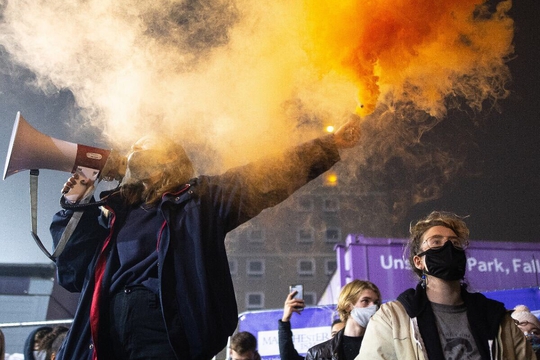The Ceding State Sedition

COVID-19 has led to disastrous implications for workers across the globe, and United States labor has been especially blighted. American teachers, whose salary and conditions have been deteriorating irrespective of a global pandemic, are now deemed ‘essential.’ They have been forced back to school, risking their lives as well as those of their students in the process.
In New Jersey, however, teachers fought back against this malignant resolve. The state’s teacher union, the NJEA (New Jersey Education Administration), called “on [their governor] and the New Jersey Department of Education to direct all New Jersey public schools to open remotely,”1 a strong move which ultimately allowed all New Jersey school districts to incorporate a virtual option into their curriculum.
New Jersey’s teacher union is evidently more formidable than those of most other American states. Montgomery, a fringe-rural town in New Jersey, is particularly renowned for its teacher union, the MTEA (Montgomery Township Education Administration). A Montgomery High School teacher has remarked that the “district is actually studied by other unions and school districts as a model for collaboration between workers and management.”
As a high schooler in Montgomery, I’ve looked to this relationship to answer whether labor is more likely to be furthered in reformist systems like Montgomery or the degraded state of non-reformist systems. Reformist systems concede with the working-class, which leads to better conditions for workers. Non-reformist systems don’t concede with the working-class, and instead institute codified means to subvert labor power.
Teacher strikes
The concept of organizing has been personal to me since my first year at the high school. Almost all my teachers expressed their solidarity with those involved in the 2018 teacher strikes in West Virginia, Oklahoma, and Arizona, by wearing a red shirt every Wednesday. This display of resistance, and the rejuvenated atmosphere which succeeded it, inspired my peers and my positive perception of labor.
While New Jersey is a Democratic state, the 2018 teacher strikes - termed the ‘Red State Revolt’ - enigmatically arose in predominantly Republican states. America’s Republican Party exists to ensure the rich’s exorbitant needs are met through lowering taxes on the 1% as well as bailing out Wall Street speculators and corporate behemoths. The party, despite this, has built a constituency based on the white working class through reactionary rhetoric dedicated to white, Christian unity. This effectively “divert[ed] the attention from capitalism and corporate power as in any way having anything to do with either the economic or the cultural problems that unbridled commercialism and individualism [create].”2
The 2018 teacher strikes started in a context often considered inhospitable to worker organising - and written off by many as right-wing bastions - yet workers stood up across these Red States to fight as a collective. This paradoxical happening only occurred through independent, majoritarian organizing; a type of organization that supersedes shallow political inclinations. This practice is necessary for broad uprising, particularly in states, like those in the Red State Revolt, whose representatives have coaxed their body politic in supporting a machine that directly opposes worker needs.
Understanding Teacher Unions in New Jersey
New Jersey is currently a blue state, although the Democrats have only held the Govenor’s office for 14 of the last 30 years. While there are important state by state differences beyond the red/blue division, we can also see a more concessionary culture in New Jersey. This culture, inspired by the compromises and pro-worker rhetoric of Democrats, stems from and causes the state’s political machine to exist as it does. This is comparatively true in red states. How does the concessionary culture in Montgomery, New Jersey, which has allowed for a strong union presence, differ from that of those states involved in the Red State Revolt? I surveyed several of my peers to find the answer.
Surveying my peers was a challenge, however, as only two out of the many teachers I reached out to actually let me distribute the survey to their students. The topic of unions, and specifically the MTEA, is evidently seen as controversial. I mainly distributed the survey covertly because of this, so the questions on the survey weren’t vetted by anyone at the school.
The survey first asked students to define the term, “labor union,” and surveyed students used progressive rhetoric fairly consistently. While one student, a known proponent of laissez-faire capitalism, blithely defined labor unions as tools to “bargain for higher wages and lower hours,” something they said is bad for teachers and students, most other students defined unions as organizations dedicated to worker rights. One student said that “labor unions are groups of people who are fighting for rights that they need to lead better lives”; another said that “unions often serve the purpose of negotiating as a block with employers and corporations in order to secure more rights and privileges for workers who would be unable to secure them by acting alone.”
These positive descriptions didn’t necessarily translate into knowledge regarding the MTEA, however. One student “unfortunately [knows] very little [about the teacher union], other than the fact… that they protested the contract issues that faced the school around 2018-2019.” Another said that “they were very active during the issue with the teachers’ contracts back in the 2018-2019 school year, [but] I’m not sure what exactly they did or do.” One student observed, rather acutely, that the members of the union “wear red on Tuesday,” (or around there, anyway).
There is a tendency among surveyed students that favors worker rights over the power of business, even when these same students are not too familiar with an immediate application of these rights. Why this is can be attributed to multiple factors. Among them is the simple truth that a unionized teacher body will instill their beliefs onto their students, even if unconsciously. I personally know and have conversed with multiple teachers regarding the union and, while the topic is taboo, they are usually open about the MTEA’s goals. Also, New Jersey itself is a labor friendly state, so bold organization is often accepted and praised by the general public. While the previous governor of New Jersey, Chris Christie, claimed that the teacher union deserves a “punch in the face,” and called it the “single most destructive force in public education,”2 the current Democratic administration of Phil Murphy saw unionized labor rise to 16.2% as compared to the national average of around 11%.3
Similar to teachers instilling pro-worker feelings into the minds of their students is my peers’ implicit understanding that labor rights are conducive to a better situation for staff and students. Montgomery High School is fairly prestigious, being ranked as the 22nd best public school in New Jersey.4 “Right-to-work” states (states which allow workers to work in a unionized workplace without paying dues), on the other hand, often see lower teacher salaries than their unionized counterparts (out of the 15 states with the highest teacher salaries, only three had right-to-work laws)5. Lower salaries often mean fewer resources, and access to less resourcing can negatively affect teacher quality. Detroit, Michigan (a right-to-work municipality) is an extreme example of this phenomenon: “the percentage of students in Detroit who performed at or above the NAEP Proficient level, [a metric used to represent academic success], was 7 percent in 2019,”6 the lowest percentage out of all American school districts.
Surveyed students further revealed the class consciousness of Montgomery when they were asked to rationalize their regard of unions. One student stated that “labor unions are a strong way to push for change in systems that can be built to oppress.” Another student said that unions “are important to secure the rights of [workers] and prevent them from being taken advantage of by… people in power, who have time and time again proven their willingness to violate said rights for personal gain.” The labor sentiment in Montgomery, which has even permeated down to the township’s youth, is obviously strong. The vast majority of surveyed students expressed a positive perception of labor even without knowing the complexities of organizing, while the minority who were anti-union took their position through already established beliefs.
Moreover, Montgomery’s perception of worker rights marks a stark difference between concessionary and non-concessionary cultures. While, in the red state revolt, union leaders deliberately focused on “big, burning demands that the vast majority of school employees and community members already felt strongly about”6 so as to not cloud the movement with ideological debates, ideology may not hinder mass movement in cultures with an established pro-worker sentiment. This is because the antecedent for broad, class solidarity already exists in these concessionary cultures. This antecedent – the idea that workers have certain rights and hold leverage over their employers – flourishes in concessionary states like New Jersey, as shown through the quotes of my peers. And while the establishment ensures that this antecedent doesn’t reach the point to which capitalism can reasonably be questioned, propagating ideology in these concessionary states can sow the seeds of an alternative mode of thought, without risking the divisiveness all too possible in cultures with a reactionary leaning.
Additionally, concessionary cultures provide another preliminary for class solidarity: the idea that labor trumps capital.
Teaching about labour
While mass media intends to alter the people’s perception of labor – diminishing its worth while praising business – political systems which provide solid platforms for their workers often create a popular sentiment that favors the working people to a further extent than condoned by the establishment. The surveyed Montgomery High School students prove this, as certain students were in favor of organizing alongside teachers to yield benefit to both parties. When asked if there is a benefit to students organizing alongside the MTEA, a student stated that a “side-by-side organization could not only help see what the teachers are asking for, but also convince students to help them reach that goal.”
While some surveyed students believe that organizing alongside teachers would be beneficial, Montgomery High School doesn’t have a student union. The only comparable body is the student government, but even that does not act as a union: the vice president of Montgomery’s student government was quoted as saying that the obligation held by the council of each class is “primarily to represent and fund our class, and not so much [to initiate] change to school policies.” It’s very possible, considering the pro-labor sentiment expressed by surveyed students, that Montgomery students could organize among themselves or with teachers. Realizing this potential, however, depends on Montgomery students themselves and whether they can mobilize like can the members of the MTEA.
Takeaways
The culture of Montgomery, which has a concessionary political establishment that rhetorically supports the rights of workers, has allowed for a fairly audacious worker body. The Montgomery teacher union evidences this, as its members fought at an admirable rate regardless of the kind of labor fought for. This is furthered when considering the fact that they did so in the public sector, as unions that exist in the public sector “win [concessions] by creating a social and political crisis,”8 rather than paralyzing business profits – a frightening idea for the meek and unsure.
This concept was seen in Montgomery when a conflict arose in 2018 between the union and the administration, revolving around whether teachers get paid for hosting extracurricular activities for their students. One Montgomery teacher said that teachers had to tread a fine line between providing for their students and demanding remuneration for their out-of-school effort – a dilemma that almost forced the union to back down. Montgomery teachers held their ground, however, and stalled extra-curricular activities in a hope to create a better situation for teachers and students; a hope which turned out successful. While the social pressure necessary in teacher organizing did affect the MTEA to some degree, it never overrode the rights seen by the union’s members as inalienable.
Ultimately, concessions provide a groundwork which allows workers to realize their latent power. As “labor grievances typically emerge not from absolute deprivation, but from relative deprivation,”[^9] incremental reforms – while intended by the establishment to subdue dissent – often produce cultures which favor worker rights. Workers in these cultures, in turn, notice discrepancies between their perceived worth as compared to their given salary, respect, and conditions. To act on this discernment as a class collective is possible through broad solidarity and strikes, as well as the fight over ideology.
The labor sentiment of Montgomery students is mirrored in the youth of other concessionary political systems. An organized teacher body can advance the bold goal of resistance to their students. Students can learn camaraderie from their teachers as well as maths.
-
See: https://www.njspotlight.com/2020/08/njs-powerful-teachers-union-says-remote-learning-this-fall/ ↩
-
See: https://www.usnews.com/education/best-high-schools/national-rankings/ ↩
-
See: https://www.business.org/hr/workforce-management/best-us-states-for-teachers/ ↩
-
See: https://nces.ed.gov/nationsreportcard/subject/publications/dst2019/pdf/2020016xr4.pdf ↩
-
Eric Blanc, The Red State Revolt, p45. ↩
-
Eric Blanc, The Red State Revolt, p21. ↩
author
Evan Zilber
Subscribe to Notes from Below
Subscribe now to Notes from Below, and get our print issues sent to your front door three times a year. For every subscriber, we’re also able to print a load of free copies to hand out in workplaces, neighbourhoods, prisons and picket lines. Can you subscribe now and support us in spreading Marxist ideas in the workplace?
Read next


